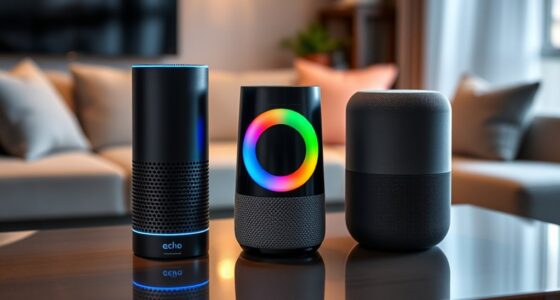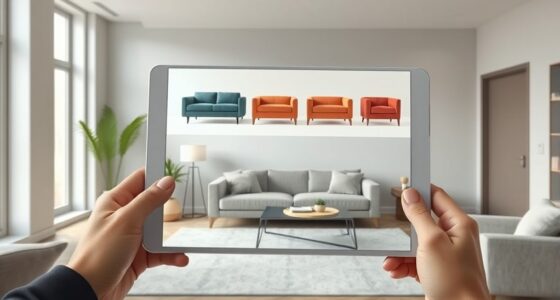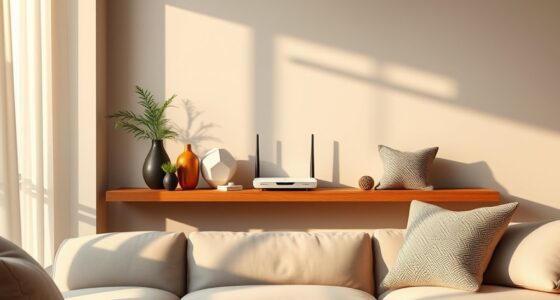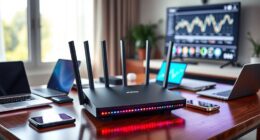Many household gadgets quietly sip power even when turned off, adding up to surprisingly high costs. Large appliances like refrigerators and HVAC systems are top consumers, but small devices in standby mode, smart home gadgets, and chargers for phones and laptops also draw significant power. Kitchen appliances with digital displays and warming plates stay lit unnecessarily. If you keep exploring, you’ll discover simple ways to cut these hidden energy drains and save more money.
Key Takeaways
- Large appliances like refrigerators and HVAC systems consume the most energy, increasing overall costs.
- Devices in standby mode, including smart TVs and chargers, can drain power quietly, raising hidden expenses.
- Small gadgets such as gaming consoles and digital displays contribute to phantom loads when not actively used.
- Using power strips and unplugging unused devices can significantly reduce unnecessary energy costs.
- Monitoring energy usage with power meters helps identify the biggest power drains and optimize appliance use.
Identifying the Biggest Energy Drainers in Your Home
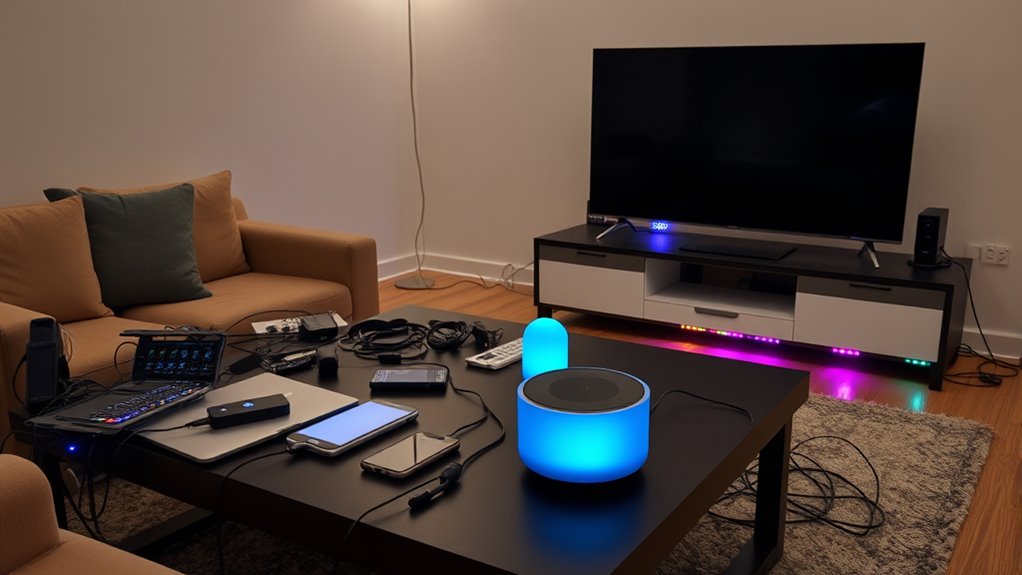
To effectively reduce your home’s energy consumption, you first need to identify which appliances and devices use the most power. Using power meters helps you track energy usage accurately, revealing which gadgets drain your electricity the fastest. Large appliances like refrigerators, HVAC systems, and water heaters often top the list, but tech gadgets such as gaming consoles and smart TVs can also be surprisingly hungry. Installing solar panels can offset some of this consumption, but knowing where your energy is going is essential before making investments. By monitoring with power meters, you can pinpoint the biggest energy drainers and prioritize upgrades or behavioral changes. Additionally, understanding family photoshoot fails can help you avoid unnecessary equipment or setups that might inadvertently increase energy use during outdoor shoots. This initial step empowers you to cut costs and reduce your carbon footprint effectively.
How Standby Mode Contributes to Power Consumption
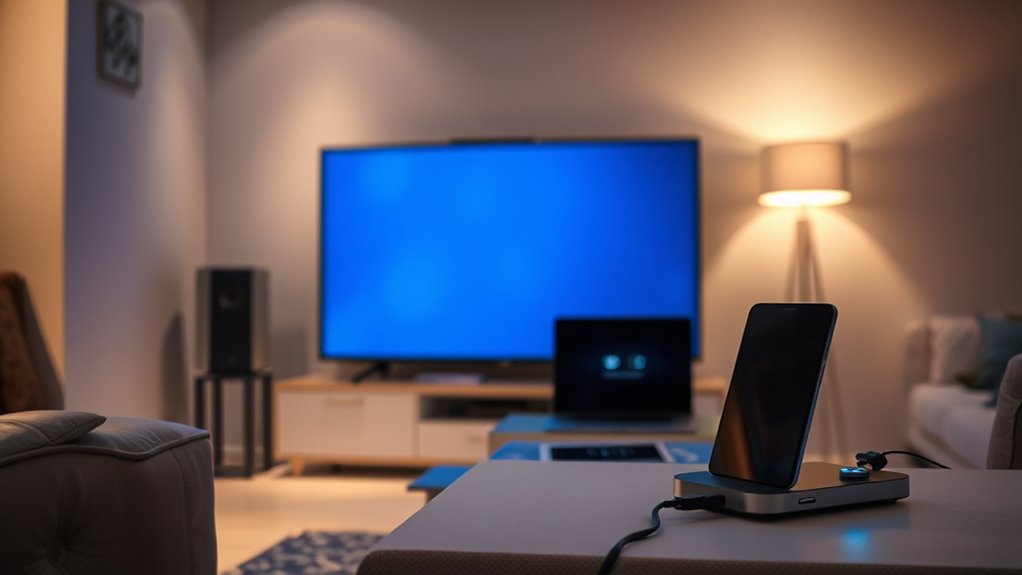
Even when your devices appear to be turned off, many still draw power in standby mode. This sneaky energy drain can profoundly impact your overall power consumption. Poor power management and lack of attention to energy efficiency mean your gadgets stay partially active, consuming electricity unnecessarily. To reduce this, consider unplugging devices when not in use or using smart power strips. Additionally, understanding the role of contrast ratio in image quality can help you select more energy-efficient projectors for your home cinema.
The Hidden Cost of Smart Home Devices
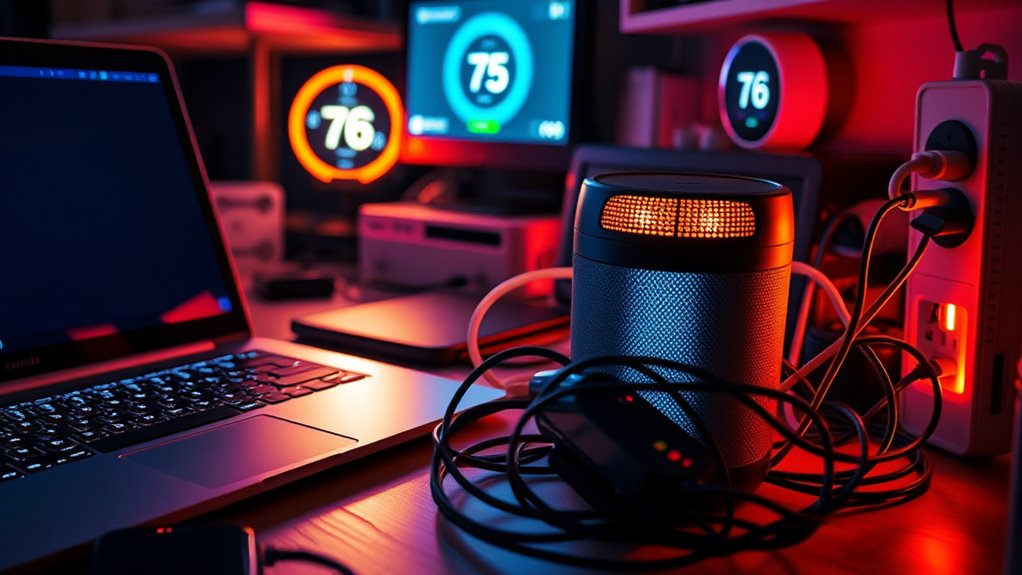
Smart home devices often draw power even when you’re not using them, adding to your energy bills. This standby power drain can quickly add up, especially with multiple gadgets. Plus, their energy consumption varies, making it harder to predict and manage costs effectively. Advances in energy efficiency technologies are helping to reduce this unnecessary power usage.
Standby Power Drain
Have you ever wondered how much energy your smart home devices waste when they’re not actively in use? That’s standby power drain—an often overlooked cost. Many devices stay in low-power mode, consuming electricity constantly due to poor power management. This hidden drain can add up over time, increasing your energy bill and reducing overall energy efficiency. To cut down on this waste, consider unplugging devices when idle or using smart power strips. Additionally, look for energy-efficient models that minimize standby consumption. High critical acclaim and box office success can sometimes be attributed to devices with better power management features.
Energy Consumption Variability
Did you know that the energy your smart home devices use can vary considerably depending on usage patterns and settings? This variability directly impacts your overall energy costs and environmental footprint. For example, devices running continuously consume more power, while those used intermittently save energy. Adjusting settings or schedules can help optimize consumption patterns. Considering renewable options, like solar-powered smart devices or integrating renewable energy sources into your home, can further reduce costs and reliance on traditional power grids. Understanding these fluctuations allows you to make smarter choices, minimizing unnecessary energy use. By managing how and when your devices operate, you not only cut costs but also contribute to a greener environment, making your smart home more efficient and sustainable.
Laptops and Smartphones: Are They Major Power Sippers?
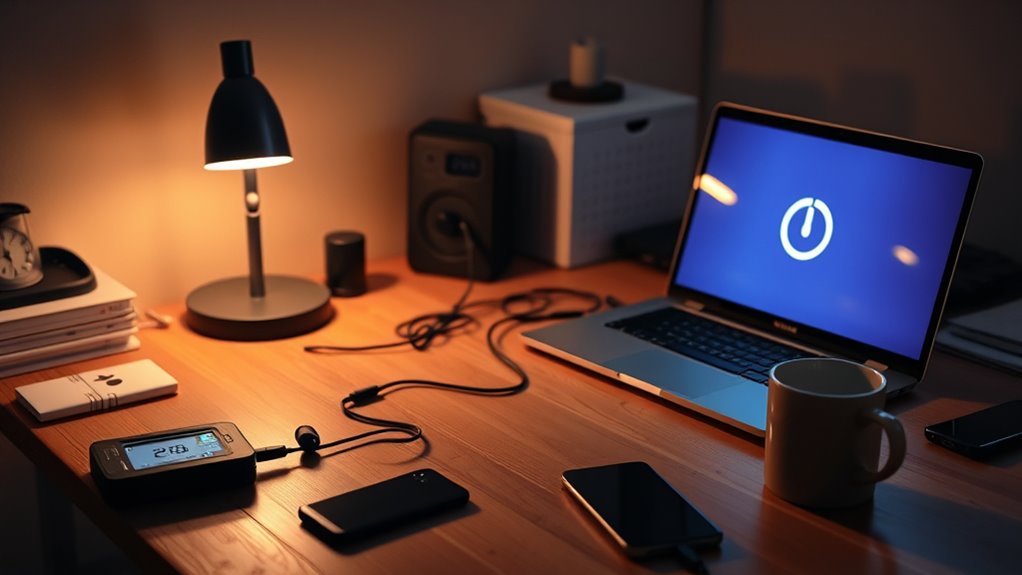
When you charge your laptop or smartphone, it uses energy even if you’re not actively using the device, adding to your overall power consumption. Standby mode also drains power quietly in the background, making these devices more energy-hungry than you might think. Additionally, many devices are designed with energy-efficient components that can help reduce their power draw during idle times. Let’s explore whether their convenience outweighs their energy demands.
Charging Energy Drain
Although laptops and smartphones are essential tools, their charging processes can contribute substantially to household energy use. Your charging habits and the battery efficiency of your devices play a big role in how much power they consume. Keeping devices plugged in longer than necessary wastes energy, even when fully charged. To reduce this drain, consider unplugging your gadgets once they reach 100%. Using chargers with better efficiency can also help minimize unnecessary power draw. Additionally, adopting smarter charging habits, like avoiding frequent overnight charging, can improve battery health and save energy in the long run. Small changes in how you charge your devices make a difference, helping you cut down on unnecessary power consumption and lower your overall energy costs. For optimal results, choosing vetted home theatre projectors and other energy-efficient gadgets can further reduce your household’s energy footprint.
Standby Power Usage
Ever wondered how much power your laptops and smartphones waste when they’re just sitting idle? Standby power can add up quickly, costing you more over time. Using a power meter during energy audits reveals that many devices draw a small but continuous current even when off or in sleep mode. This “phantom load” may seem insignificant, but it accumulates, especially with multiple gadgets. To help you visualize, here’s a quick comparison:
| Device | Average Standby Power | Estimated Annual Cost |
|---|---|---|
| Laptop | 2-6 watts | $10-$30 |
| Smartphone Charger | 0.5-1 watt | <$5 |
| Smart TV | 1-4 watts | $10-$25 |
| Printer | 1-3 watts | $8-$20 |
| Gaming Console | 1-5 watts | $12-$28 |
Regular energy audits can identify these sneaky power drains, saving you money.
Kitchen Gadgets and Appliances: Surprising Energy Wasters
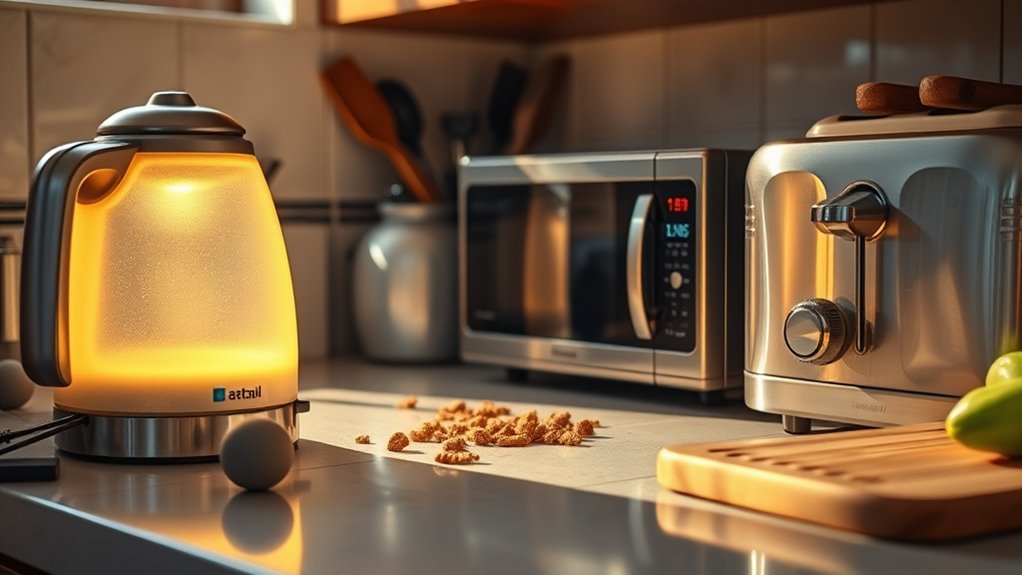
Many kitchen gadgets and appliances quietly drain energy even when you’re not actively using them. These subtle power draws add up, increasing your overall appliance energy costs. Common culprits include:
- Coffee makers that keep warming plates on standby
- Microwave clocks that run constantly for no real reason
- Toaster ovens with digital displays that stay lit
Even when turned off, some kitchen gadgets still consume power, making them surprisingly energy-wasting. These small but persistent drains can considerably impact your energy bill over time. To cut back, consider unplugging appliances when not in use or investing in smart power strips that cut power automatically. Being aware of these hidden energy wasters helps you reduce unnecessary appliance energy consumption and saves you money.
Practical Tips to Reduce Power Usage and Save Money
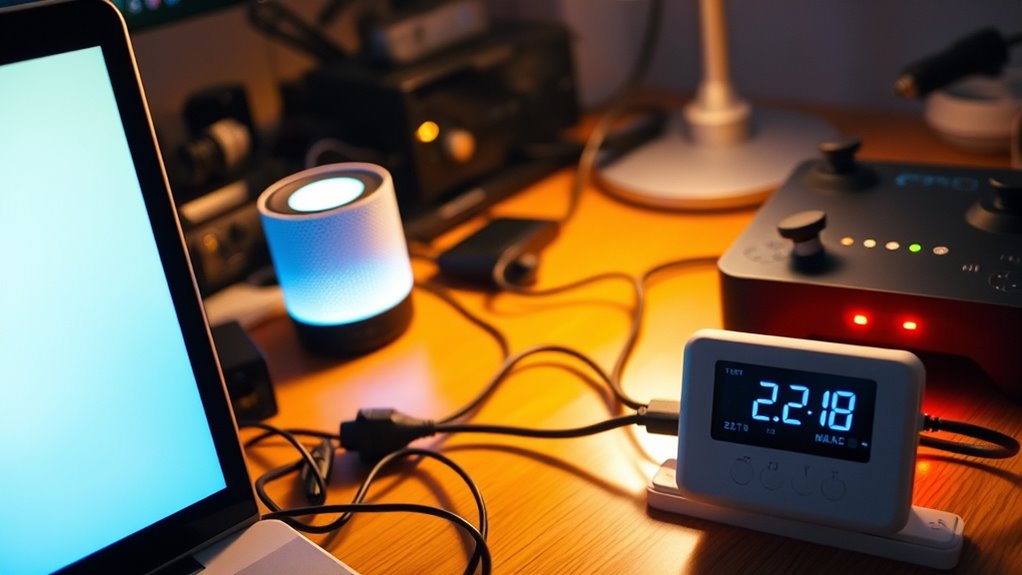
To effectively reduce your power usage and save money, start by unplugging appliances when you’re not using them, especially those with standby modes. This simple energy efficient tip prevents phantom loads that drain power unnecessarily. Regular appliance maintenance also boosts efficiency, ensuring your devices run smoothly and consume less energy. Consider using smart power strips to easily turn off multiple devices at once. Adjusting your thermostat and optimizing device settings can further cut costs. Here’s a reminder of some practical steps:
| Action | Benefit | Emotional Impact |
|---|---|---|
| Unplug unused gadgets | Stops energy waste | Feel empowered and in control |
| Schedule maintenance | Keeps appliances efficient | Experience peace of mind |
| Use energy-efficient bulbs | Reduce lighting costs | Feel proud of your eco-friendliness |
| Lower screen brightness | Saves power on devices | Stay confident in your choices |
| Regularly update software | Improve device performance | Enjoy seamless operation |
Additionally, understanding phantom loads can help you identify hidden energy drains in your home.
Frequently Asked Questions
Which Household Appliances Consume the Most Electricity Annually?
You might be surprised to learn that appliances like refrigerators, air conditioners, and water heaters use the most electricity annually. To understand your household’s energy consumption, you should consider a smart meter and an energy audit. These tools help identify high-energy appliances, so you can take steps to decrease power use and save money. Regularly monitoring your energy use ensures you’re aware of which appliances are the biggest power hogs.
How Can I Accurately Measure My Device’S Power Consumption?
To accurately measure your device’s power usage, you should use energy monitoring tools like a plug-in power meter. Simply plug your device into the monitor, and it will display real-time energy consumption. This helps you understand your device’s power usage and identify which gadgets are the biggest energy drain. Regular energy monitoring allows you to make smarter choices, save on electricity bills, and reduce your overall energy footprint.
Are Newer Gadgets More Energy-Efficient Than Older Models?
Newer gadgets tend to be more energy-efficient thanks to technological advancements that improve power management and reduce consumption. You’ll find that updated models often use less electricity while delivering better performance. By choosing the latest devices, you’re benefiting from innovations designed to save energy, which helps lower your utility bills and environmental impact. So, upgrading your gadgets can be a smart move if you want to maximize energy efficiency.
Do Power Strips Really Help Reduce Standby Power?
You might think power strips are just for convenience, but they really help with standby power reduction. Many power strip myths suggest they don’t make a difference, but in reality, turning off a strip cuts power to multiple devices at once, saving energy. By using a power strip, you actively reduce standby power, lowering your electricity bill and helping the environment. It’s a simple step toward more energy-efficient gadget use.
What Are the Long-Term Cost Savings of Upgrading to Energy-Efficient Devices?
Upgrading to energy-efficient devices can lead to significant long-term savings by reducing your energy bills and enhancing your overall energy saving strategies. These appliances often have a longer lifespan, meaning fewer replacements and less maintenance costs over time. While the initial investment might be higher, you’ll benefit from lower utility costs and a smaller environmental footprint, making it a smart choice for both your wallet and the planet.
Conclusion
Did you know that leaving your gadgets on standby can waste up to 10% of your home’s energy? By being mindful and unplugging devices or switching them off fully, you could substantially cut costs and save hundreds annually. It’s surprising how small changes make a big difference—so next time, take a moment to power down. Your wallet and the environment will thank you for it!


